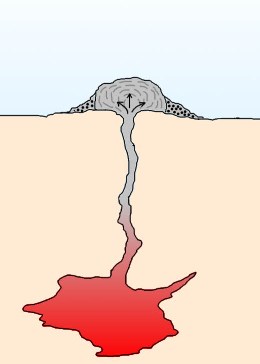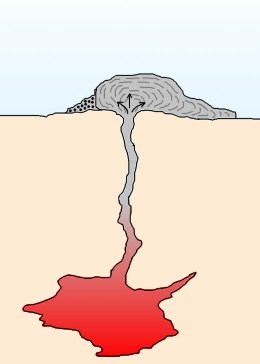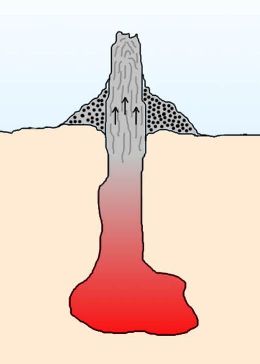Le versant Est du sommet du Mézenc offre un magnifique point de vue sur le plateau ardéchois, parsemé de nombreux sucs.
Si ces sucs ont tous une origine volcanique, ils présentent toutefois des formes très différentes.
La formation des sucs
Au Miocène (-20 Millions d'années), les mouvements tectoniques qui vont former les Alpes entrainent un soulèvement du plateau hercynien. Lors de ce soulèvement, le plateau se fracture et le magma va s'infiltrer dans ses lignes de fracture. La lave présente ici est très visqueuse, peu gazeuse et relativement froide (700°) et va aboutir à des volcans de type péléens, un type de volcan défini en 1902 après l'éruption de la montagne Pelée en Martinique. La lave s'élève et en se solidifiant constitue une aiguille rocheuse ou un dôme. Selon la viscosité de la lave et le terrain environnant, la forme des protubérances va varier.
les types de sucs

|
 |
|
Dôme aux pentes fortes
la lave très visqueuse ne s'écoule pas et forme un dôme qui gonfle de l'intérieur
|
Dôme aplati
la lave est moins visqueuse et s'affaisse sur les côtés
|
|
|

|

|
|
Dôme-coulée
une viscosité encore plus faible et/ou la topographie permet une expansion latérale plus marquée et forme une langue
|
Protusion
la lave est très visqueuse et à sa sortie, elle conserve le diamètre qu'elle avait dans la cheminée, sans expansion latérale. Cela forme un pain de sucre aux pentes raides, le cas le plus connu étant le Gerbier de Joncs
|
La phonolithe
En se refroidissant la lave a donné de la phonolithe : une roche grise, riche en feldspath et qui émet un son clair quand on la frappe d'où son nom (phono = son). Elle se débite en dalles, utilisées dans la région pour construire les toits en lauzes.
Depuis la table d'orientation, en regardant vers le Sud vous verrez de droite à gauche : en contrebas la vaste cirque des Boutières créé par plusieurs épisodes éruptifs, au loin le Gerbier de Joncs, l'imposant Suc de Sara facilement reconnaissable à sa forme pyramidale (il s'agit d'un ring dyke), le suc de Touron, le suc de Gouleyou et les Roches de Borée.
Pour valider cette Earthcache, envoyez-moi vos réponses aux questions suivantes :
Question 1 : Combien de pieds a la table d'orientation?
Question 2 : A quel type de sucs appartient le Touron ?
Question 3 : A quel type de sucs appartient le Gouleyou?
Question 4 : Emettez votre propre hypothèse qui expliquerait la forme du Mézenc avec son double sommet
Question 5 : Postez une photo de vous ou votre GPS avec le suc de votre choix en arrière-plan
Rappel concernant les Earthcaches : il n'y a pas de contenant à trouver ni de logbook à signer.
Loguez un "found it" et envoyez-moi vos réponses soit via mon profil, soit via la messagerie geocaching.com. Je vous contacterais en cas de problèmes.
Tout log enregistré sans envoi des réponses sera supprimé.
The eastern side of the summit of Mézenc offers a magnificent view on the Ardèche plateau, dotted with many lava dome called here "sucs".
If these sucs all have a volcanic origin, they have very different shapes.
Origins of sucs
At Miocene (-20 million years), the tectonic movements that will form the Alps lead to a lifting of Hercynian plate. During this lifting, the tray fractures and magma will seep into its fracture lines. The lava is very viscous present here, with any gas and relatively cold (700 °) and will result in the type of peléen volcano, a volcano type defined in 1902 after the eruption of Mount Pelee in Martinique. The lava rises and solidifies constitutes a rocky needle or a dome. Depending on the viscosity of the lava and the surrounding terrain, the shape of protuberances will vary.
Types of sucs

|
 |
|
High dome
the very viscous lava does not flow and forms a dome which swells to the inside
|
Low dome
the lava is less viscous and collapses on the sides
|
|
|

|

|
|
D0me coulée
an even lower viscosity and / or topography allows a greater lateral expansion on a side
|
Upheaved Plug
the lava is highly viscous and its output, it retains the diameter it had in the stack, without lateral expansion, the most outstanding example being the Gerbier de Joncs
|
The phonolithe
On cooling lava gave the phonolithe : a gray rocks, rich in feldspar and emits a clear sound when struck the hence its name (phono = sound). It delivers slabs, used in the region to build the slate roof.
From the viewpoint, looking to the south you will see from right to left : the vast Boutières circus created by several eruptive episodes, the Gerbier de Joncs, the imposing Suc of Sara easily recognized by its pyramid shape (it's a ring dyke), the Suc de Touron, the Suc de Gouleyou and the Rocks of Borée.
To validate this Earthcache, send me your answers to the following questions:
Question 1 : How many legs have the orientation table?
Question 2 : What is the type of the Suc de Touron?
Question 3 : What is the type of the Suc de Gouleyou?
Question 4 : Propose your own hypothesis to explain the shape of the Mézenc with his double summit
Question 5 : Post a photo of yourself or your GPS with the suc of your choice in the background
Reminder concerning Earthcaches: there is no finding or containing logbook to sign.
Log in a "found it" and send me your answers either via my profile, either via geocaching.com mail. I will contact you in case of problems.
Just log saved without sending replies will be deleted.